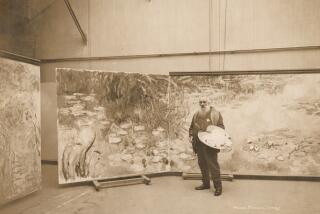De Kooning: A Life Apart in His Art
- Share via
NEW YORK — Every day, Willem de Kooning is helped out of bed by his nurses. They dress him, help him shave and fix breakfast for him. He rarely speaks, and when he does the nurses or visitors who come to see him cannot understand what he is trying to say.
Regarded as one of the world’s greatest living painters, De Kooning, 85, must receive help for virtually every little thing he needs during the day, according to his oldest friends. They say he is lost to them now, that he no longer recognizes them when they appear for coffee or conversation at his large studio in the pine barrens in the East Hampton community of Springs, N.Y.
Now, his daughter has begun proceedings in New York Supreme Court questioning his ability to oversee an estimated $150 million worth of his artworks.
Miraculously, though, his friends say De Kooning’s descent into what some say is Alzheimer’s disease has not diminished his art.
“He is painting the best work of his life,” said Ibram Lassaw, an East Hampton sculptor who has known De Kooning for more than 50 years. “He has no memory, really. He shakes my hand firmly when I walk over to see him, but I am not sure he recognizes me.
“But his work is wonderful,” Lassaw added. “I was in his studio just two weeks ago, and his paintings were just excellent. He greets the canvas as if it were a part of his anatomy, like an arm or a leg. It’s a miracle, really.”
Miracle or no, Lisa de Kooning, 33, is asking the court to declare her father mentally incompetent to manage his property. She asks that she and her father’s attorney, John Eastman, be declared co-conservators of the artist’s estate, which includes an estimated 300 paintings stored in a specially built, refrigerated facility next to the artist’s studio.
The court papers and an accompanying report written by a court-appointed fact finder, lawyer Pierre Lundberg, paint a vivid picture of De Kooning’s condition. But in addition, the report quotes an art dealer as saying that De Kooning has been producing the best work of his life.
‘Unintelligible’ Response
On a March 2 visit to De Kooning’s studio, Lundberg wrote, he observed the artist “walking back and forth and around his large combination studio and residence. . . . He appeared to be affable, and when I tried to ask him questions he would utter a response that would be unintelligible to me.
“I could elicit no direct or meaningful response to any question I asked. . . . I asked him whether he received a presidential award, and Lisa attempted to stimulate his response by mentioning President Johnson, but he gave no intelligible response.”
Lundberg quoted an art dealer, Arnold Glimcher, as saying that “the work currently being carried out in the studio . . . was among the best De Kooning work he had ever seen; he said it made him believe there was a special part of the brain that controlled or made an artist.”
Conflicting Observations
Dr. Frederick Mortati, a neurologist, examined De Kooning at the painter’s home Feb. 5 and said it “would appear from my examination that Mr. De Kooning suffers from Alzheimer’s disease. . . . In my professional opinion, (he) is no longer capable of managing his personal and business affairs.”
Alzheimer’s disease is a degenerative process resulting from the loss of cells from the cerebral cortex of the brain. Memory loss is the most prominent early symptom.
A friend, painter Herman Cherry, said his last visit to De Kooning’s studio convinced him that something “incredible” was going on.
“Here is a man who can’t recognize people, who needs help dressing and shaving every morning, yet I think he is now doing some of the most beautiful paintings he has ever done.
“He worked before in an immediacy, without too much reflection. And now you get a feeling of meditation, of deep reflection. His knowledge is so inbred in him that he can’t make a mistake.”
More to Read
Sign up for Essential California
The most important California stories and recommendations in your inbox every morning.
You may occasionally receive promotional content from the Los Angeles Times.













